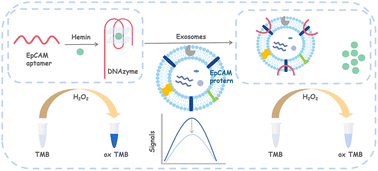A colorimetric aptasensor based on a hemin/EpCAM aptamer DNAzyme for sensitive exosome detection†
Abstract
Exosomes are considered as potential biomarkers that can reflect information from their parent cell-associated cancer microenvironment. Recently, aptasensors have been widely used for cancer and tumor exosome detection. Aptamers related to exosome surface proteins are usually used to introduce a sequence; the aptamer is used for exosome recognition, and the introduced sequence is used to form G-quadruplexes and for signal amplification. In this paper, we found that the EpCAM aptamer is rich in guanine and unimolecular G-quadruplex with a two-layer G-tetrad under acidic conditions, and we investigated its topology, thermal stability and dissociation constant with hemin. Based on this, our proposed colorimetric aptamer sensor combines the unmodified EpCAM aptamer with hemin to construct a hemin/G-quadruplex DNAzyme and catalyze the TMB–H2O2 system to generate a strong colorimetric signal. Therefore, colorimetric signal changes were negatively correlated with the exosome concentration. The linear range of the 1 h assay was 106–108 particles per mL, and the detection limit was 3.94 × 105 particles per mL. In addition, this method can detect exosomes in complex fetal bovine serum samples with good specificity and high sensitivity toward exosomes from breast, liver, and lung cancers with abnormal EpCAM protein expression.



 Please wait while we load your content...
Please wait while we load your content...